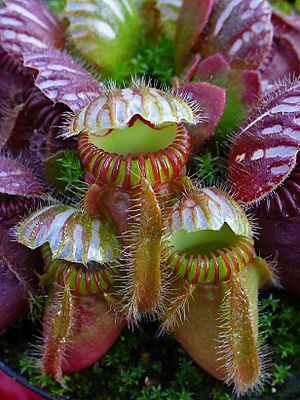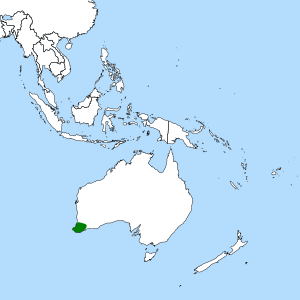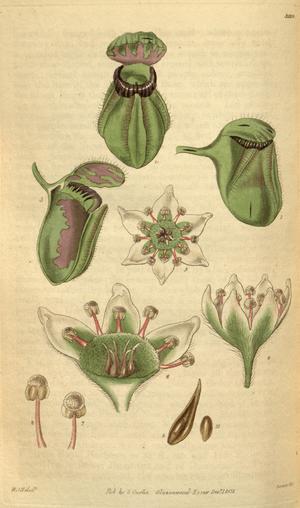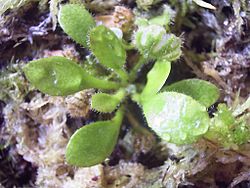Cephalotus facts for kids
Quick facts for kids Cephalotus |
|
|---|---|
 |
|
| Conservation status | |
| Scientific classification | |
| Genus: |
Cephalotus
|
| Species: |
follicularis
|
 |
|
| Global range | |
The Cephalotus (say: sef-uh-LOH-tus) is a special kind of plant. It's a genus with only one species, called Cephalotus follicularis. You might know it better as the Albany pitcher plant.
This small, meat-eating pitcher plant gets its name from its unique leaves. These leaves look like little pitchers or cups. People also call it the "Western Australian pitcher plant" or "fly-catcher plant" because of how it catches insects.
Contents
What is the Albany Pitcher Plant?
The Albany pitcher plant is a small plant that grows close to the ground. It has green leaves that stay all year round. These leaves come from roots hidden underground.
Some of its leaves are changed into special traps. These traps look like little moccasins or pitchers. They can turn dark red if they get a lot of sunlight. In shadier spots, they stay green. These pitcher leaves usually make the plant about 20 centimeters tall.
How Does It Trap Insects?
The 'pitcher' trap works like other pitcher plants. At the opening of the trap, there's a spiky rim called the peristome. These spikes let insects crawl in easily, but they make it very hard for them to get out.
There's also a lid over the opening, called the operculum. This lid stops rainwater from getting into the pitcher. If rain got in, it would water down the special enzymes inside that help the plant digest its prey.
The lid also has clear spots that look like patches of sky. This can confuse insects, making them fly into the trap. Once inside, insects get stuck in the digestive fluid and become food for the plant.
Flowers and Winter Sleep
The Albany pitcher plant also grows small, creamy white flowers. These flowers grow in groups.
In the colder months of winter, when temperatures drop to about 5 degrees Celsius, the plant takes a break. This is called a natural dormancy period. It lasts about 3 to 4 months. This rest is triggered by the colder weather and less sunlight.
History of Discovery
This unique plant was first found by scientists in Australia. It was seen in December 1801 and January 1802. The botanist Robert Brown wrote about it in his diary.
Later, in 1806, another scientist named Jacques Labillardière officially described the plant. He gave it the name Cephalotus follicularis. At first, he thought it was related to roses. But later, scientists realized it was so special that it needed its own plant family, called Cephalotaceae.
Where It Fits in the Plant World
The Albany pitcher plant is a very unique plant. It's actually more closely related to plants like apples and oaks than to other pitcher plants you might know. It belongs to a group of plants called Oxalidales.
Its family, Cephalotaceae, has only this one type of plant. This means it's very special and only found in a specific area.
Where It Lives
The Albany pitcher plant grows in the southern coastal areas of Western Australia. You can find it in wet, sandy places like swamps or along creeks. It can also grow in slightly drier spots.
Sadly, its natural home is shrinking because of human activities. Also, too many plants have been collected from the wild. Because of this, the IUCN lists it as a Vulnerable species. This means it needs protection. However, in Australia, it's not currently listed as threatened by national or local laws.
Who Lives in the Pitchers?
Interestingly, the larvae (young stage) of a special type of fly called Badisis ambulans live inside the pitchers of this plant. These flies look like ants and have never been found living anywhere else!
Growing Your Own Plant
People all over the world enjoy growing Cephalotus. If you want to grow one, here are some tips:
- They like warm days (up to 25 degrees Celsius) and cool nights during their growing season.
- They grow well in a mix of peat moss, perlite, and sand.
- They prefer a good amount of humidity (60–80%).
- You can grow new plants from root or leaf cuttings.
- Letting the plant have a cool, quiet period in winter is important for its long-term health.
- If you give them lots of direct sunlight, their pitchers will turn a beautiful dark color. In shadier spots, they stay green.
The first living plants were brought to Kew Gardens in England in 1823. One of these plants flowered in 1827.
This plant has even won an award! The Royal Horticultural Society gave it their Award of Garden Merit.
There are many different types of Cephalotus that people grow. Some have even been officially named as special varieties. For example, 'Eden Black' is a popular type with very dark pitchers.
Images for kids





